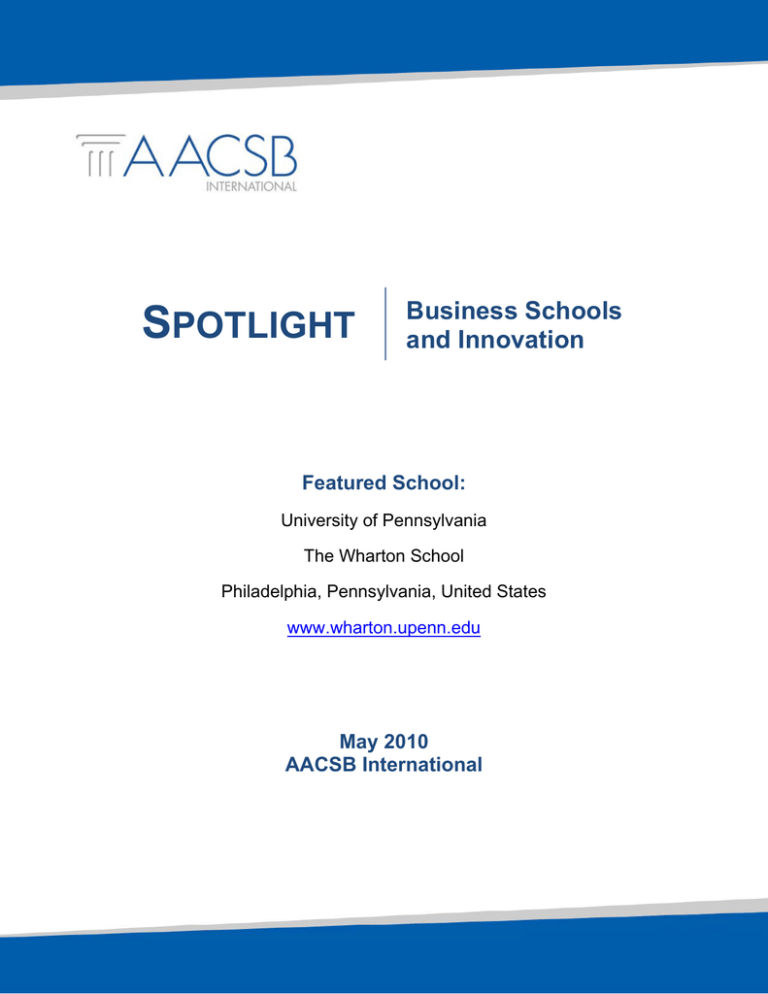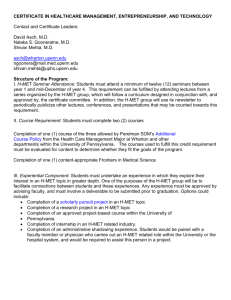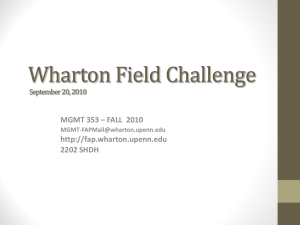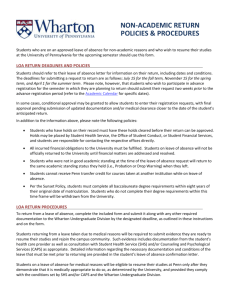
SPOTLIGHT
Business Schools
and Innovation
Featured School:
University of Pennsylvania
The Wharton School
Philadelphia, Pennsylvania, United States
www.wharton.upenn.edu
May 2010
AACSB International
SPOTLIGHT | Business Schools & Innovation
University of Pennsylvania | 2
The Wharton School
Innovation is a theme running throughout more than a century of the Wharton School’s history1. Indeed, a
“Commitment to Innovation” is one of three values the school has identified to define the Wharton School
brand2. This has not always been the case for the businesses that employ Wharton’s graduates, however.
According to Dr. William Hamilton, the University of Pennsylvania’s Ralph Landau Professor of
Management and Technology, innovation has not always received the extensive attention from industry
and corporate strategists that it does today.
Given today’s broad usage of the term innovation, and its broad application to a wide range of initiatives,
Hamilton believes it is important to carefully define the school’s approach to innovation to avoid a dilution
of its focus. To that end, the partnership between the Wharton School and the Penn Engineering School
is one that, to a large extent, focuses on technological innovation. Dr. Hamilton observes that innovation
and technology are common threads running through the research streams of many professors.
The Jerome Fisher Program in Management and Technology (M&T)
The University of Pennsylvania has a long history of supporting interdisciplinary activity. According to
Hamilton, the willingness of various schools at the university to work together as peers is a part of the
university’s academic culture. The Jerome Fisher Program in Management and Technology (M&T)3,
whose students simultaneously pursue bachelor’s degrees offered by the Wharton and Penn Engineering
Schools, is one such interdisciplinary activity. The M&T Program was begun in 1979, growing out of
recommendations from the engineering school’s Board of Overseers, a distinguished group of business
executives and academics, who saw the need for employees who could bridge technology and business4.
With such a lengthy history, the M&T program has amassed a large body of alumni, reaching over 1,500
within its first 30 years of operation despite the relatively small size of the program. The M&T Program
now matriculates about 50 freshmen per year, and despite pressures from time to time to double its
intake, plans are to maintain that average cohort size. There are good reasons not to increase the size of
the M&T program. For one thing, the program is administered by a staff which only added its third
member within the last few years. The three M&T program staff members include Hamilton,
Administrative Director January Stayton, and Administrative Coordinator Jaime Davis.
Its relatively small size and commonality of interests also allow the M&T student community to become
very tight-knit5. The program is housed in an independent location, between both the Wharton School and
the Penn Engineering School. Actual courses are taught in one of the two schools (and often crosslisted). M&T students have access to program-specific academic and career advising services from
© AACSB International. All Rights Reserved.
SPOTLIGHT | Business Schools & Innovation
University of Pennsylvania | 3
program staff and peer advisors, in addition to what both the Wharton and Penn Engineering Schools
individually offer them. Alumni also tend to remain highly involved with the program as guest speakers,
resident scholars, facilitators of career seminars, mentors, etc. Hamilton plans to enable even greater
alumni involvement with the program by creating an Advisory Board, largely composed of alumni.
According to Hamilton, the M&T program has remained a dual degree program because of a belief that
the two schools have spectacular students who satisfy the requirements of both degree programs, and
they therefore should receive both degrees. The Wharton School’s approach to dual degree programs
such as M&T is that each program has its own discipline and standards – and that these can be
preserved while also creatively combined. “The [M&T] program itself remains as it was pretty much when
we started it in the framework, that is, we allow students to take courses almost wherever they want as
long as they fit within categories. But we’ve kept to one simple rule: Each school defines the requirements
for its degree,” says Hamilton6.
Indeed, the curriculum of the M&T program is highly subject to individual tailoring. As full citizens of both
Penn Engineering and the Wharton School, M&T students have all the options of each school available to
them. Penn Engineering offers two separate degree choices to M&T students: a Bachelor of Science in
Engineering (BSE) or a Bachelor of Applied Science (BAS) in Engineering. Depending on the engineering
concentration they choose as their major, M&T students have access to a wide range of courses from
across the engineering spectrum. On the Wharton side, M&T students also choose at least one business
major from a menu of over 17 concentrations, in areas ranging from Finance to Accounting, Marketing,
Operations & Information Management, etc., and many choose more than one7. A host of minors are also
available at Wharton, Penn Engineering, or even other schools at the University of Pennsylvania.
Since 1995, the program has been endowed by a $5.5 million donation from Penn alumnus Jerome
Fisher, and this in addition to other gifts covers the program’s operating expenses. In the past, the
program used to be funded through support from the two schools, which Dr. Hamilton admits was uneven
at times. The University of Pennsylvania operates on a responsibility budgeting model, in which every
school has its own budget and is an economic entity unto itself, receiving a share of tuition revenue. M&T
program tuition is split evenly between the Wharton and Penn Engineering Schools.
M&T Student Involvement with other Innovation-Related Programs
Beyond merely fulfilling degree requirements, Hamilton notes that M&T students also take leading roles in
a number of other activities undertaken by the Wharton School and the university in support of innovation.
M&T students currently hold the chair positions in four of the six student committees at the Weiss Tech
House8, a campus hub that was created in 2003 to promote undergraduate innovation and commercial
© AACSB International. All Rights Reserved.
SPOTLIGHT | Business Schools & Innovation
University of Pennsylvania | 4
development of new technologies9. In addition to leadership opportunities, the Weiss Tech House offers
lab space, tools, mentoring and networking opportunities, and funding for new ideas through grants and
student business plan competitions. Weiss Tech House also has the involvement of entrepreneurs who
participate as advisors, speakers, networking contacts, etc. Hamilton indicates that a significant number
of M&T students have plans to start their own company, though he often advises them to do this later
after having gained more post-graduation work experience.
The Wharton School offers the Wharton Entrepreneurial Programs (WEP), based at the Sol C. Snider
Entrepreneurial Research Center. The WEPs are longstanding educational and research programs
focused on technological innovation that are available at all academic levels10. For undergraduate
students such as those in the M&T program, the WEP takes the form of a 4-credit Specialization in
Entrepreneurship and Innovation, with a diverse set of electives, as well as one core course in
Technology Innovation and Entrepreneurship designed specifically for M&T students11. Similarly, Penn
Engineering also offers an Engineering Entrepreneurship minor program, in which M&T students are free
to partake12.
Although its resources are more targeted at faculty research, the Mack Center for Technological
Innovation13 also sees participation from the undergraduate M&T program’s students, primarily in the form
of research assistance on its various projects. At the Mack Center, research is supported by participating
member companies who both fund and also suggest issues for research.
Students have endless options made available via the combination of centers and programs, says
Hamilton, who is at some level personally involved in each of them. When asked where the boundaries
are between the different organizations, Hamilton replies that there are none. Indeed, he sees the overlap
in focus with regard to technological innovation among the various programs and centers as a positive,
and the resulting tight relationships between organizations on campus as beneficial for all concerned. Employment options post-graduation are likewise broad for M&T students, as their training makes them
highly eligible for numerous positions. The majority (50-60%) are employed by financial services firms,
says Stayton, because these organizations have recognized the innovative talent pool provided by the
M&T program and recruit heavily from it. Consulting and technological firms are also very common
employers of M&T graduates14.
Acknowledgements: AACSB International is grateful for the assistance of Dr. William Hamilton, Faculty
Director of the Fisher M&T Program and Ralph Landau Professor of Management and Technology, and
Ms. January Stayton, Administrative Director of the Fisher M&T Program.
© AACSB International. All Rights Reserved.
SPOTLIGHT | Business Schools & Innovation
© AACSB International. All Rights Reserved.
University of Pennsylvania | 5
SPOTLIGHT | Business Schools & Innovation
University of Pennsylvania | 6
End Notes
1
The Wharton School of the University of Pennsylvania. (2010) Wharton: A Century of Innovation.
Electronic document, http://www.wharton.upenn.edu/innovation/index.html, accessed March 24, 2010.
2
The Wharton School of the University of Pennsylvania. (2010) The Brand Values. Electronic document,
http://www.wharton.upenn.edu/standards/brand_values.cfm, accessed March 24, 2010.
3
University of Pennsylvania. (2010) The Jerome Fisher Program in Management & Technology, Home
Page. Electronic document, http://www.upenn.edu/fisher/, accessed March 24, 2010.
4
The Wharton School of the University of Pennsylvania. (2010) The Athletic Innovators of M&T. Wharton
Entrepreneurial Programs, Get It Started, February 2010. Electronic document,
http://wep.wharton.upenn.edu/gis/article.aspx?gisID=154, accessed March 24, 2010.
5
University of Pennsylvania. (2010) M&T Marks a Three-Decade Wharton-Engineering “Marriage.” The
Pennsylvania Gazette, Jan/Feb 2010. Electronic document,
http://www.upenn.edu/gazette/0110/gaz04mt.html, accessed April 7, 2010.
6
University of Pennsylvania. (2004) Management & Technology: A Winning Combination. The
Pennsylvania Gazette, Nov/Dec 2004. Electronic document,
http://www.upenn.edu/gazette/1104/1104gaz07.html, accessed March 24, 2010.
7
University of Pennsylvania. (2010) The Jerome Fisher Program in Management & Technology, The
Curriculum. Electronic document, http://www.upenn.edu/fisher/curriculum/index.html, accessed April 19,
2010.
8
Weiss Tech House. (2010) Committees. Electronic document, http://www.techhouse.upenn.edu/dynamic/site/committees/index.php, accessed April 7, 2010.
9
University of Pennsylvania. (2004) A House Built with Ideas. The Pennsylvania Gazette, Mar/Apr 2004.
Electronic document, http://www.upenn.edu/gazette/0304/0304gaz12.html, accessed March 24, 2010.
10
The Wharton School of the University of Pennsylvania. (2010) Wharton Entrepreneurial Programs,
Home Page. Electronic document, http://wep.wharton.upenn.edu/default.aspx, accessed April 19, 2010.
11
The Wharton School of the University of Pennsylvania. (2010) Wharton Entrepreneurial Programs,
Undergraduate Division, Goergen Entrepreneurial Management Program, Requirements for the
Specialization in Entrepreneurship & Innovation. Electronic document,
http://wep.wharton.upenn.edu/documents/WEP_UG_courses_and_specialization_2010-2011.pdf,
accessed April 19, 2010.
12
University of Pennsylvania, School of Engineering and Applied Sciences. (2010) Engineering
Entrepreneurship, Program Overview. Electronic document,
http://www.seas.upenn.edu/entrepreneurship/overview.php, accessed May 7, 2010.
13
The Wharton School of the University of Pennsylvania. (2010) Mack Center for Technological
Innovation, Home Page. Electronic document, http://mackcenter.wharton.upenn.edu/, accessed April 7,
2010.
14
University of Pennsylvania, Career Services. (2009) School of Engineering and Applied Science
Summer Career Plan Survey, Class of 2009 Overview. Electronic document,
http://www.vpul.upenn.edu/careerservices/seas/summerCl09.pdf, accessed April 7, 2010. Wharton
Undergraduate Class of 2009 Career Plans Survey Report. Electronic document,
http://www.vpul.upenn.edu/careerservices/wharton/surveys/Wharton2009Report.pdf, accessed April 7,
2010. © AACSB International. All Rights Reserved.



